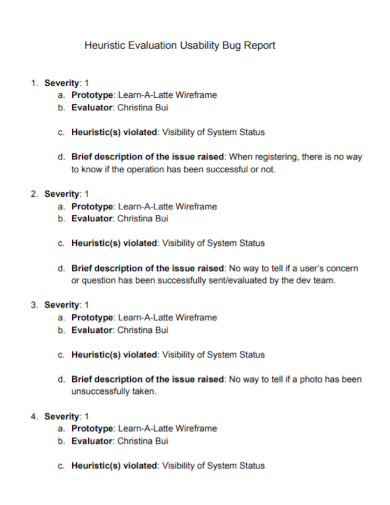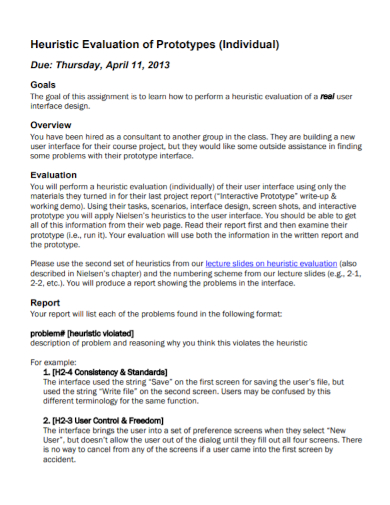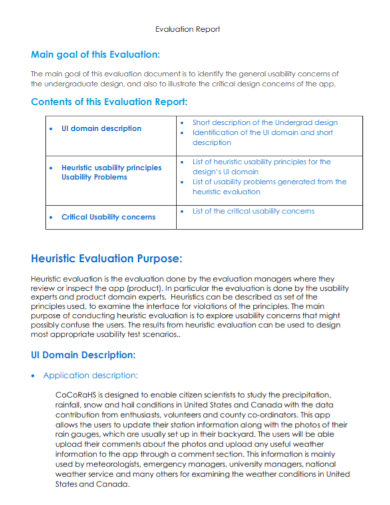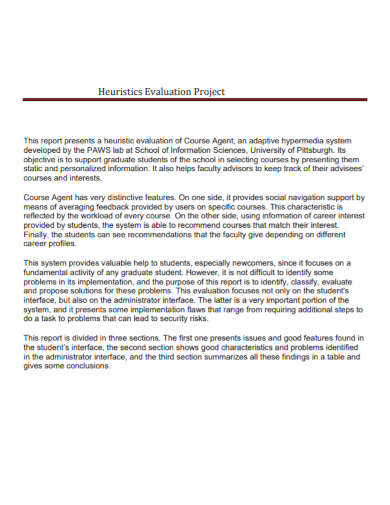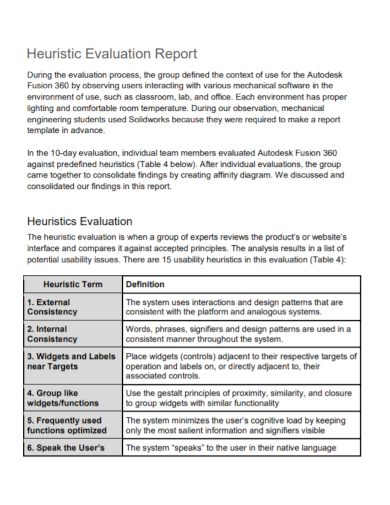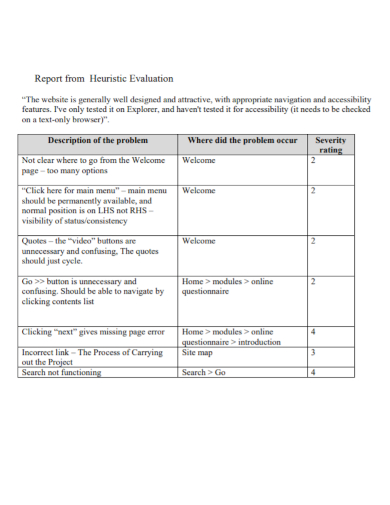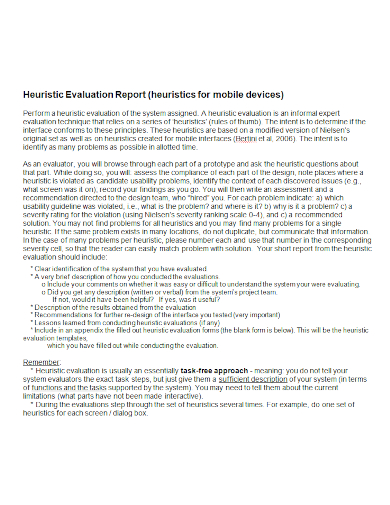It is a procedure in which specialists utilize rules of thumb to assess the usability of user interfaces in independent walkthroughs and report any flaws that they encounter. Evaluators employ well-established heuristics (e.g., Nielsen- Molich’s) and uncover insights that may be used by design teams to improve the usability of their products from the beginning of the development process.
Learn how to do a heuristic review on every user interface design that you come across. Using the techniques in this article, you will be able to build and conduct your own heuristic evaluations to improve the usability, utility, and desirableness of your designs. First off, check out these heuristic evaluation report samples that we have listed for you down below. After getting to know the document, what it looks like, and how it works, feel free to use these samples as guides or even as templates for when you write the document on your own.
7+ Heuristic Evaluation Report Samples
1. Heuristic Evaluation Usability Report
2. Heuristic Evaluation Usability Bug Report
3. Heuristic Evaluation Individual Report
4. Heuristic Evaluation Report
5. Heuristic Evaluation Project Report
6. Sample Heuristic Evaluation Report
7. Standard Heuristic Evaluation Report
8. Editable Heuristic Evaluation Report
What Is a Heuristic Evaluation Report?
Designers are now encouraged to develop their own design-specific heuristics to use in evaluating their products, systems, websites, and other similar endeavors. Technology has advanced since Nielsen and Molich devised these heuristics in the 1990s, and as a result, they are less applicable to many of the items that are currently accessible on the market. Examples include designs meant for online communities or mobile devices where the working environment is continuously changing, so Nielsen and Molich’s heuristics would be too general to evaluate usability. However, despite the special capabilities and limits of modern designs, the original heuristics are still in large part applicable. Because of this, as a designer, it is critical that you learn to incorporate Nielsen and Molich’s heuristics into your designs as a starting point for your work. Therefore, rather than dominating the process with Nielsen and Molich’s heuristics, their 10 rules of thumb should only be used to inform and inspire the development of specific heuristics by designers and companies, rather than dictating the process with Nielsen and Molich. The use of your company or product-specific heuristics, in conjunction with market research, other design criteria, and needs, will improve the suitability of the design under consideration.
How To Write a Heuristic Evaluation Report
Finding and inventing new heuristics is a difficult endeavor in and of itself; there are no firm suggestions because each design presents its own set of unique goals, restrictions, functions, styles, and other variables, and there are no definitive recommendations. However, the majority of heuristic evaluations consist of between five and ten criteria, which are selected based on their relevancy to the overall usability of the system, website, application, or another piece of software under consideration. Less than five heuristics may result in a lack of stringency when identifying potential problems and issues, but more than ten heuristics may overburden the evaluator because they must analyze the design while keeping all of the heuristics in mind, and the heuristics may also be in conflict with one another. You can begin by generating and executing your own heuristic evaluation by following the steps listed below:
- Establish an appropriate list of heuristics
Make use of Nielsen and Molich’s ten heuristics and Ben Shneiderman’s eight golden guidelines as inspiration and a stepping stone to your own creative process. Ensure that they are used in conjunction with other applicable design guidelines and market research. - Select your evaluators
Make certain that your evaluators are chosen with care. Users who are not evaluators should not be the target audience. In most cases, they should be usability specialists, with a preference for those with domain expertise in the industry type in which your product is being used. Example: A Point-of-Sale system for the restaurant business should be evaluated by someone who has at least a basic grasp of the operations of a restaurant. - Brief your evaluators
So that they are fully aware of the tasks and topics that they are expected to complete and cover throughout their evaluation Briefing sessions should be standardized so that all assessors receive the same instructions; otherwise, you may find that their evaluation is influenced. Within this brief, you may choose to request that the evaluators concentrate on a specific set of tasks; however, they may also declare which tasks they will cover based on their previous experience and knowledge, if applicable. - First evaluation phase
The first appraisal, which takes around two hours on average, is dependent on the type and complexity of the product. The product will be used freely by the evaluators in order for them to have a feel for the ways of engagement and the scope. After that, they will choose specific elements that they wish to examine in further depth. - Second evaluation phase
During the second evaluation step, the evaluators will conduct a second run-through while applying the heuristics that they have chosen to the items that were detected during the first evaluation phase. Individual aspects would be scrutinized by the evaluators, who would also consider how well they fit into the overall design. - Record problems
If the evaluators encounter problems, they must either record them themselves or you should record them as they carry out their various jobs so that you can keep track of any issues they experience. It is important to request that the assessors be as clear and comprehensive as possible when recording problems. - Debriefing session
The debriefing session entails teamwork between the several assessors in order to compile their findings and create a comprehensive list of issues. Using the heuristics, they should be encouraged to suggest potential solutions to the challenges they have encountered.
FAQs
How do you present heuristic findings?
One or more of the following elements should be included in a successful heuristic evaluation report: Checklists: To demonstrate how well heuristic standards have been followed, you can summarize the findings in your report by using a checklist or grading system (for example, a scale of 1-10) to show how closely the findings have been followed.
What is a good heuristic evaluation?
Heuristic evaluation is the process of having a small group of evaluators examine an interface and determine whether or not it complies with well accepted usability guidelines.
What are the 3 types of heuristics?
- Availability
- Representativeness
- Anchoring and adjustment
The ability to develop your own heuristics is a valuable talent to have. When analyzing interface design, you and your team will be guided by the heuristics developed by Jakob Nielsen and Rolf Molich as well as your own observations. This will allow you and your team to provide better experiences for your users. Heuristic evaluation can be a valuable inspection tool; nevertheless, some experts have observed concerns with evaluators reporting false alarms rather than genuine problem aspects within designs, rather than genuine problem parts inside designs. It is beneficial to use a variety of different evaluators, collect their problems, and conduct a debriefing session to weed out false alarms at various phases of the design process in order to minimize the impact that misreporting has on the applicability of findings from heuristic evaluation.
Related Posts
FREE 11+ Sample Performance Evaluation Forms
FREE 10+ Summative Evaluation Form Samples
FREE 10+ Custody Evaluation Report Samples
FREE 10+ Mental Status Examination Report Samples
FREE 10+ Mental Status Examination Report Samples
FREE 9+ Work Evaluation Form Samples
FREE 9+ Marketing Evaluation Form Samples
FREE 9+ Sample Meeting Evaluation Forms
FREE 8+ Neuropsychological Evaluation Report Samples
FREE 8+ Sample Conference Evaluation Forms
FREE 12+ Sample Evaluation Forms
FREE 10+ Sample Workshop Evaluation Forms
FREE 9+ Sample Project Evaluation
FREE 9+ Sample Presentation Evaluation Forms
FREE 8+ Sample Employee Self Evaluation Forms


